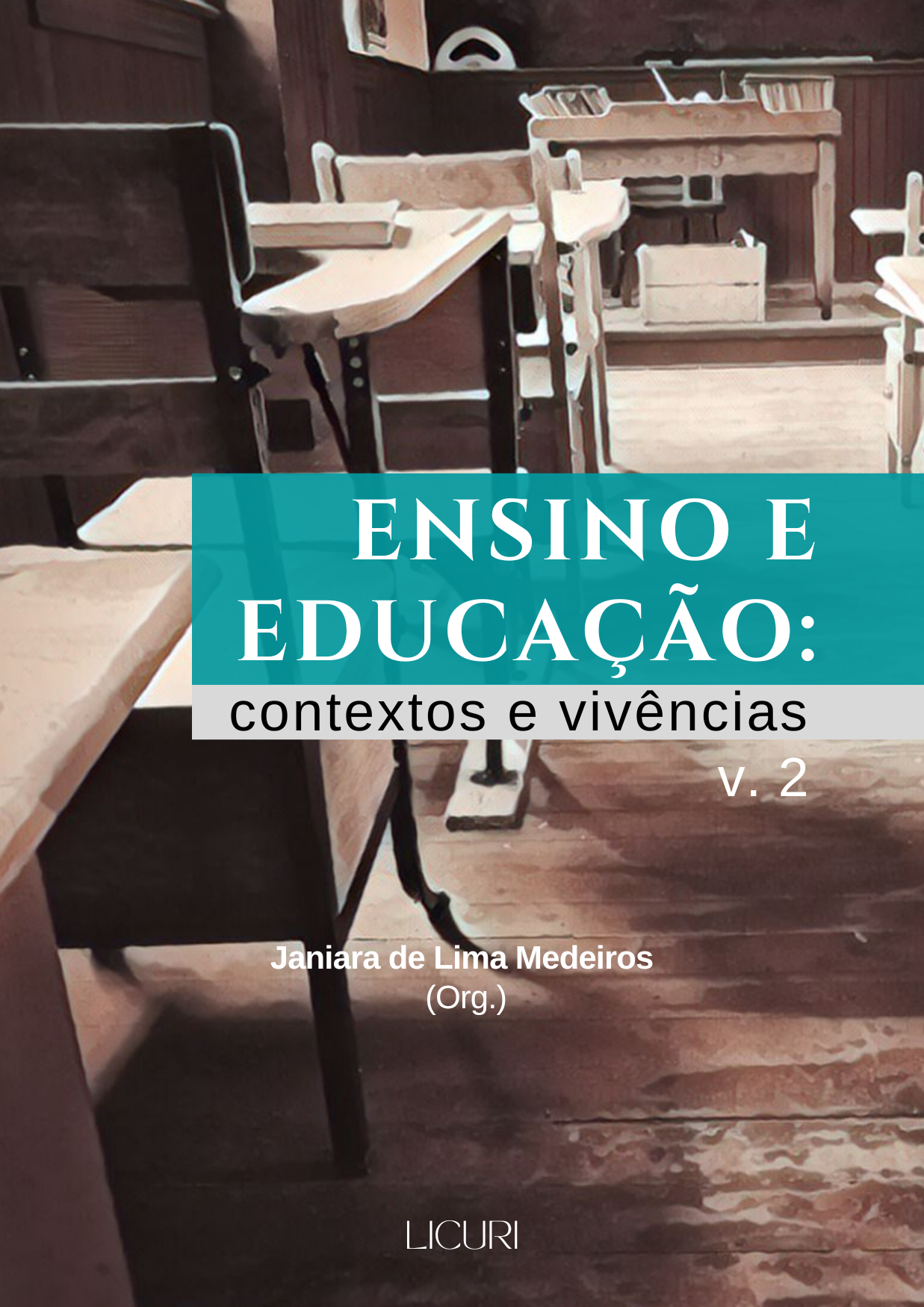Concepções de criatividade por educadores do ensino fundamental
DOI:
https://doi.org/10.58203/Licuri.83100Palavras-chave:
Concepção de Criatividade, Educandos, Educadores, CriatividadeResumo
O papel que o educador exerce no estímulo à criatividade dos educandos no período que estes se encontram nas escolas tem sido cada vez mais objeto de estudo de pesquisadores ao redor do mundo. A concepção que o professor tem sobre a criatividade pode influenciar na maneira como ele percebe e estimula o desenvolvimento dela nos estudantes. Desta forma, este estudo pretendeu analisar as concepções de criatividade de professores do Ensino Fundamental. Para coleta de dados foi utilizado um questionário composto por questões abertas realizado por meio do Google Forms. Os resultados apontam que a maior parte dos professores compreende a criatividade como o ato de criar, inovar, modificar, adaptar, improvisar, desenvolver produtos ou ideias e solucionar problemas.
Downloads
Referências
Alencar, E., & Fleith, D. (2003). Criatividade: Múltiplas perspectivas (3 ed.). Universidade de Brasília.
Alencar, E., & Fleith, D. (2008). Barreiras à promoção da criatividade no Ensino Fundamental. Psicologia: Teoria e Pesquisa, 24(1), 59–65. http://dx.doi.org/10.1590/S0102-37722008000100007
Alencar, E., Fleith, D., Boruchovitch, E., & Borges, C. (2015). Criatividade no ensino fundamental: Fatores inibidores e facilitadores. Psicologia: Teoria e Pesquisa, 31(1), 105–114. http://dx.doi.org/10.1590/0102-37722015011849105114
Amabile, T. (1983). The social psychology of creativity: A componential conceptualization. Journal of Personality and Social Psychology, 42(2), 357–376. http://dx.doi.org/10.1037/0022-3514.45.2.357
Beghetto, R. (2007). Does creativity have a place in classroom discussions? Prospective teachers’ response preferences. Thinking Skills and Creativity, 2(1), 1–9. http://dx.doi.org/10.1016/j.tsc.2006.09.002
Beghetto, R. (2017). Creativity in teaching. In J. C. Kaufman, V. P. Glăveanu, & J. Baer (Eds), The Cambrigde Handbook of Creativity across Domains (pp. 549–564). Cambridge University Press. https://doi.org/10.1017/9781316274385.030
Beghetto, R. A. (2021). Creative learning in education. In M. L. Kern, & M. L. Wehmeyer (Eds), The Palgrave Handbook of Positive Education (pp. 473–492). Palgrave Macmillan. https://doi.org/10.1007/978-3-030-64537-3
Birgili, B. (2015). Creative and critical thinking skills in problem-based learning environments. Journal of Gifted Education and Creativity, 2(2), 71–80. https://doi.org/10.18200/JGEDC.2015214253
Bramwell, G., Reilly, R., Lilly, F., Kronish, N., & Chennabathni, R. (2011). Creative teachers. Roeper Review, 33(4), 228–238. https://doi.org/10.1080/02783193.2011.603111
Coutinho, M. (2011). Análise de conteúdo: breve histórico, conceitos e aplicabilidade. In M. Coutinho, & E. Saraiva (Eds.), Métodos de pesquisa em psicologia social: perspectivas qualitativas e quantitativas (pp. 17–66). Editora Universitária.
Csikszentmihalyi, M. (1988). Society, culture, and person: A systems view of creativity. In R. Sternberg & J. Davisdon (Eds.), The nature of creativity: Contemporary psychological perspectives (pp. 325-339). Cambridge University Press.
Csikszentmihalyi, M. (1996). Creativity: flow and the psycology of discover and invention. HarperCollins Publishers.
Fleith, D.S., Vilarinho-Rezende, D., &; Alencar, E.M.L.S. (2020). O modelo Componencial de Criatividade de Teresa Amabile. In Neves-Pereira, M & Fleith, D. (Eds.). Teorias da Criatividade, (pp.48–62). Ed Alínea.
Freire, P. (2005). Pedagogia do Oprimido (43 ed.). Paz e Terra.
Freire, P. (2006). Pedagogia da Autonomia (34 ed.). Paz e Terra.
Hennessey, B., & Amabile, T. (2010). Creativity. Annual Review of Psychology, 61(1), 569–598. https://doi.org/10.1146/annurev.psych.093008.100416
Kaufman, J., & Beghetto, R. (2009). Beyond big and little: The four c model of creativity. Review of General Psychology, 13(1), 1–12. https://doi.org/10.1037/a0013688
Lubart, T. (2007). Psicologia da Criatividade. Artmed.
Martinez, A. (2002). A criatividade na escola: Três direções de trabalho. Linha Críticas, 08(15), 189–206. https://doi.org/10.26512/lc.v8i15.3057
Nakano, T., & Wechsler, S. (2018). Creativity and innovation: Skills for the 21st century. Estudos de Psicologia, 35(3), 237–246. http://dx.doi.org/10.1590/1982-02752018000300002
Neves-Pereira, M., & Fleith, D. (2020). Teorias da Criatividade. Alínea.
Oliveira, E., & Alencar, E. (2010). Características de professores criativos e de coordenadores. Boletim Academia Paulista de Psicologia, 30(79), 379–393. https://www.redalyc.org/pdf/946/94615412011.pdf
Patston, T., Kaufman, J., Cropley, A., & Marrone, R. (2021). What is creativity in education? A qualitative study of international curricula. Journal of Advanced Academics, 32(2), 207–230. https://doi.org/10.1177/1932202X20978356
Runco, A. (2022). Positive creativity and the intentions, discretion, problem finding, and divergent thinking that Support it can be encouraged in the classroom. Education Science, 12(5), Article 340. https://doi.org/10.3390/educsci12050340
Runco, M., Acar, S., & Cayirdag, N. (2017). A closer look at the creativity gap and why students are less creative at school than outside of school. Thinking Skills and Creativity, 242–249. https://doi.org/10.1016/j.tsc.2017.04.003
Runco, M., & Albert, R. (2010). Creativity research: A historical view. In J. Kaufman, & R. Sternberg (Orgs), The Cambridge handbook of creativity (pp. 3–20). Cambridge University Press.
Runco, M., & Jaeger, G. (2012). The standard definition of creativity. Creativity Research Journal, 24(1), 92–96. https://doi.org/10.1080/10400419.2012.650092
Satlher, T., & Fleith, D. (2010). Estímulos e barreiras à criatividade na educação a distância. Estudos de Psicologia (Campinas), 27(4), 457–466. http://dx.doi.org/10.1590/S0103-166X2010000400004
Selby, E., Treffinger, D., Isaksen, S., & Lauer, K. (2004). Defining and assessing problem-solving style: Design and development of a new tool. The Journal of Creative Behavior, 18(4), 221–243. http://dx.doi.org/10.1002/j.2162-6057.2004.tb01242.x
Simonton, D. K. (1975). Sociocultural context of individual creativity: A transhistorical time series analysis. Journal of Personality and Social Psychology, 32(6), 1119–1133. https://doi:10.1037//0022-3514.32.6.1119
Simonton, D. K. (1997). Historiometric-Studies of Creative Genius. In M.A., Runco, (Ed.). The Creativity Research Handbook. (pp. 3–28). Hampton Press.
Sternberg, R. (2015). Teaching for creativity: The sounds of silence. Psychology of Aesthetics, Creativity, and the Arts, 9(2), 115–117. http://dx.doi.org/10.1037/aca0000007
Torrance, P. (1965). Scientific views of creativity and factors affecting its growth. Daedalus, 94(3) 663–681. https://www.jstor.org/stable/20026936
Torrance, E. P. (1995). Why fly? A philosophy of creativity. Ablex.
Treffinger, D. (2021). Practice problems for creative problem solving. Routledge. http://dx.doi.org/10.4324/9781003237211
Valverde, J., Thornhill-Miller, B., Patillon, T.-V., & Lubart, T. (2020). Creativity: A key concept in guidance and career counselling. Journal of Adult and Continuing, 0(0), 1–12. http://dx.doi.org/10.1177/1477971420903736
Vigotski, L. (2014). Imaginação e criatividade na infância. WMF Martins Fontes.
Virgolin, A., Neves-Pereira, M., & Fleith, D. (2012). Toc, toc... plim, plim! Lindando com as emoções, brincando com o pensamento através da criatividade. Papirus.
Weiner, R. (2000). Creativity and beyond: Culture, values, and change. University of New York Press.
Downloads
Publicado
Edição
Seção
Licença
Copyright (c) 2023 Editora Licuri

Este trabalho está licenciado sob uma licença Creative Commons Attribution-NonCommercial 4.0 International License.




